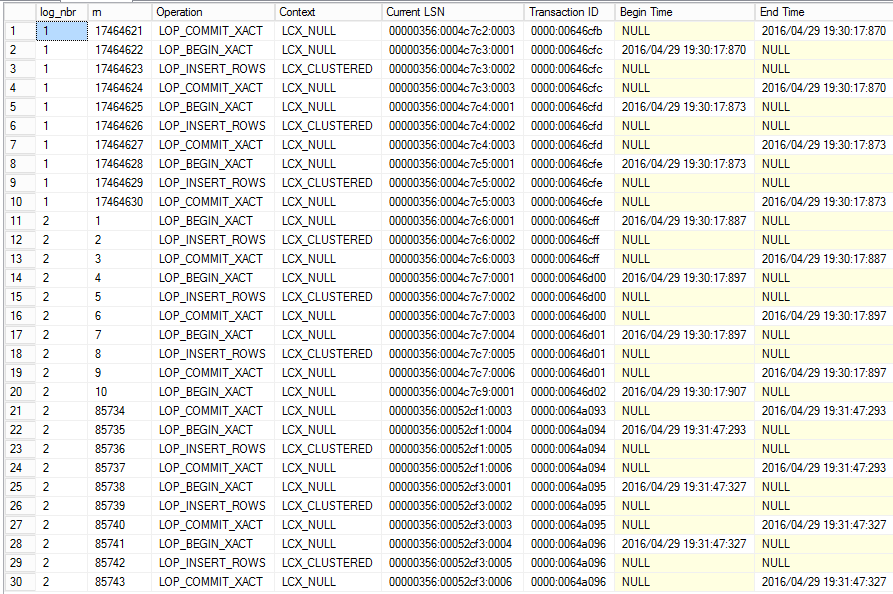I had an interesting situation come up recently, and it boiled down to this. Suppose I start a transaction log backup at 10:00:00 and it runs for one minute, until 10:01:00. Is a transaction that happened at 10:00:30 included in the backup? Let’s do an experiment.
I have a sample database containing customers and orders, and an application that fires up a bunch of threads and inserts random data into the database. So I kicked off the application and let it run for several hours so as to generate a bunch of log records. I disabled the normal log backups for the duration of this test.
With the application still running, I then kicked off a transaction log backup, introduced a brief delay, followed by a second log backup.
backup log CorpDB to disk = 'S:\Backup\SQL2014\Log\log1.trn' with init, compression; waitfor delay '0:00:10'; backup log CorpDB to disk = 'S:\Backup\SQL2014\Log\log2.trn' with init, compression; |
Now I want to look in the header of my backup files.
restore headeronly from disk = 'S:\backup\sql2014\Log\log1.trn'; restore headeronly from disk = 'S:\backup\sql2014\Log\log2.trn'; |
I see that the first log backup started at 7:30:17 pm and ended at 7:31:37, and the second backup ranged from 7:31:47 to 7:31:47. Unfortunately, this is only stored with one-second resolution, but we can see that the first backup ran for about 80 seconds.
So the question now is which backup contains a transaction that occurred at, say, 7:30:30?
I’m going to load the transaction log records into a couple of temp tables.
select row_number() over (order by [Current LSN]) rn, * into #log1 from sys.fn_dump_dblog(null, null, 'disk', 1, 'S:\backup\sql2014\Log\log1.trn', default, default, default, default, default, default, default, default, default, default, default, default, default, default, default, default, default, default, default, default, default, default, default, default, default, default, default, default, default, default, default, default, default, default, default, default, default, default, default, default, default, default, default, default, default, default, default, default, default, default, default, default, default, default, default, default, default, default, default, default, default, default, default); create clustered index ix1_log1 on #log1 (rn); select row_number() over (order by [Current LSN]) rn, * into #log2 from sys.fn_dump_dblog(null, null, 'disk', 1, 'S:\backup\sql2014\Log\log2.trn', default, default, default, default, default, default, default, default, default, default, default, default, default, default, default, default, default, default, default, default, default, default, default, default, default, default, default, default, default, default, default, default, default, default, default, default, default, default, default, default, default, default, default, default, default, default, default, default, default, default, default, default, default, default, default, default, default, default, default, default, default, default, default); create clustered index ix1_log2 on #log2 (rn); |
Now let’s take a look at the last 10 records in the first log file, the first 10 records in the second log, and the last 10 records in the second log.
select 1 log_nbr, rn, Operation, Context, [Current LSN], [Transaction ID], [Begin Time], [End Time] from #log1 where rn >= (select max(rn) from #log1) - 9 union all select 2 log_nbr, rn, Operation, Context, [Current LSN], [Transaction ID], [Begin Time], [End Time] from #log2 where rn <= 10 union all select 2 log_nbr, rn, Operation, Context, [Current LSN], [Transaction ID], [Begin Time], [End Time] from #log2 where rn >= (select max(rn) from #log2) - 9 order by log_nbr, rn; |
The first backup contains log records through 7:30:17.873, and the second backup starts with log records a few milliseconds later at 7:30:17.887 and ends at 7:31:47.327. In other words, the second log contains the records covering the 90 seconds between the start times of the two log backups.
To answer my specific question I can also find a transaction that happened at 7:30:30 pm in the second log file:
select top 1 rn, Operation, Context, [Current LSN], [Transaction ID], [Begin Time], [End Time] from #log2 where [Begin Time] >= '2016/04/29 19:30:30' order by [Begin Time]; |
From this, I conclude that a log backup includes transactions up to approximately the BackupStartDate contained in the header, and not the BackupEndDate.
Caveat: I only tried this on SQL Server 2014 SP1 Developer Edition. It is entirely possible that other versions / service packs / editions behave differently.

